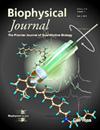Extending MMPBSA for membrane proteins: Addressing P2Y12R conformational changes upon ligand binding.
IF 3.2
3区 生物学
Q2 BIOPHYSICS
引用次数: 0
Abstract
Membrane proteins play crucial roles in biological signaling and represent key targets in drug discovery, garnering significant experimental and computational attention. Recent advances in computational screening techniques have enabled the development of more accurate and efficient binding affinity calculation methods. Among these, the Molecular Mechanics Poisson Boltzmann Surface Area (MMPBSA) method has gained widespread adoption in large-scale simulations due to its computational efficiency. However, its application to membrane protein-ligand systems remains less developed compared to globular protein systems, primarily due to the additional complexity introduced by the membrane environment. In this study, we present enhanced capabilities in Amber that provide flexible and automatic options for calculating membrane placement parameters. Furthermore, we present the first application of ensemble simulations, combined with a multi-trajectory approach and entropy corrections, to enhance MMPBSA calculations for membrane protein systems. This novel methodology is particularly advantageous for systems exhibiting large ligand-induced conformational changes, significantly improving accuracy and sampling depth compared to traditional single-trajectory methods. We validate our approach using the human purinergic platelet receptor P2Y12R as a model system, chosen for its well-documented agonist-induced conformational changes and extensive experimental data, making it an ideal candidate for evaluating our enhanced simulation protocol.扩展膜蛋白的MMPBSA:定位配体结合时P2Y12R构象的变化。
膜蛋白在生物信号传导中起着至关重要的作用,是药物发现的关键靶点,获得了重要的实验和计算关注。计算筛选技术的最新进展使更准确和有效的结合亲和力计算方法得以发展。其中,分子力学泊松-玻尔兹曼表面积(MMPBSA)方法因其计算效率高而在大规模模拟中得到广泛应用。然而,与球状蛋白系统相比,它在膜蛋白配体系统中的应用仍然不太发达,主要是由于膜环境引入了额外的复杂性。在这项研究中,我们展示了Amber的增强功能,为计算膜放置参数提供了灵活和自动的选择。此外,我们提出了集成模拟的第一个应用,结合多轨迹方法和熵校正,以增强膜蛋白系统的MMPBSA计算。与传统的单轨迹方法相比,这种新方法对于表现出大配体诱导构象变化的系统特别有利,显着提高了精度和采样深度。我们使用人类嘌呤能血小板受体P2Y12R作为模型系统验证我们的方法,选择它是因为它有充分记录的激动剂诱导的构象变化和广泛的实验数据,使其成为评估我们增强模拟方案的理想候选。
本文章由计算机程序翻译,如有差异,请以英文原文为准。
求助全文
约1分钟内获得全文
求助全文
来源期刊

Biophysical journal
生物-生物物理
CiteScore
6.10
自引率
5.90%
发文量
3090
审稿时长
2 months
期刊介绍:
BJ publishes original articles, letters, and perspectives on important problems in modern biophysics. The papers should be written so as to be of interest to a broad community of biophysicists. BJ welcomes experimental studies that employ quantitative physical approaches for the study of biological systems, including or spanning scales from molecule to whole organism. Experimental studies of a purely descriptive or phenomenological nature, with no theoretical or mechanistic underpinning, are not appropriate for publication in BJ. Theoretical studies should offer new insights into the understanding ofexperimental results or suggest new experimentally testable hypotheses. Articles reporting significant methodological or technological advances, which have potential to open new areas of biophysical investigation, are also suitable for publication in BJ. Papers describing improvements in accuracy or speed of existing methods or extra detail within methods described previously are not suitable for BJ.
 求助内容:
求助内容: 应助结果提醒方式:
应助结果提醒方式:


